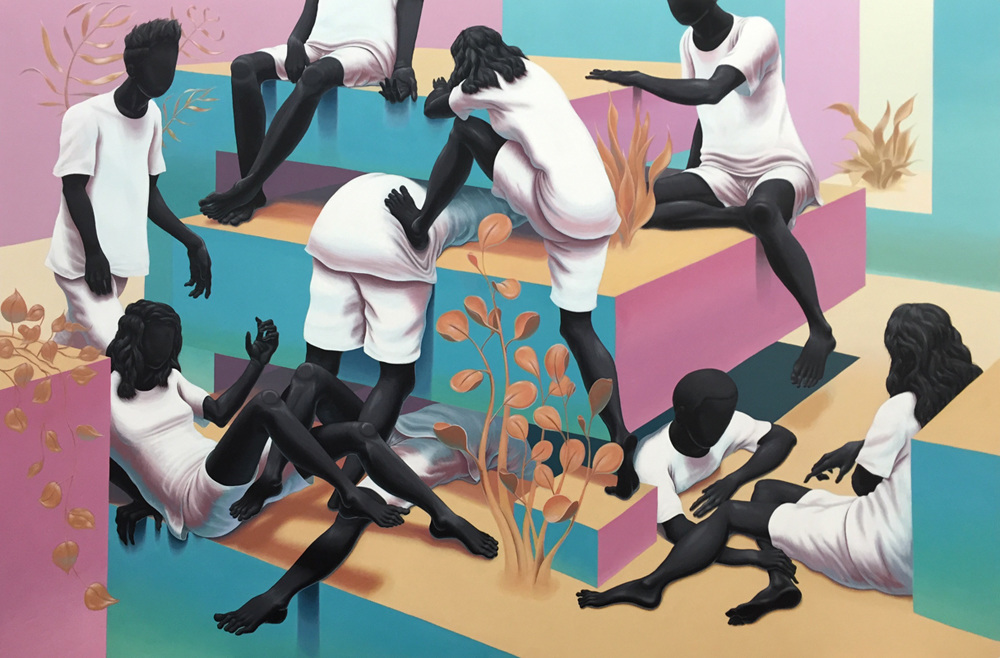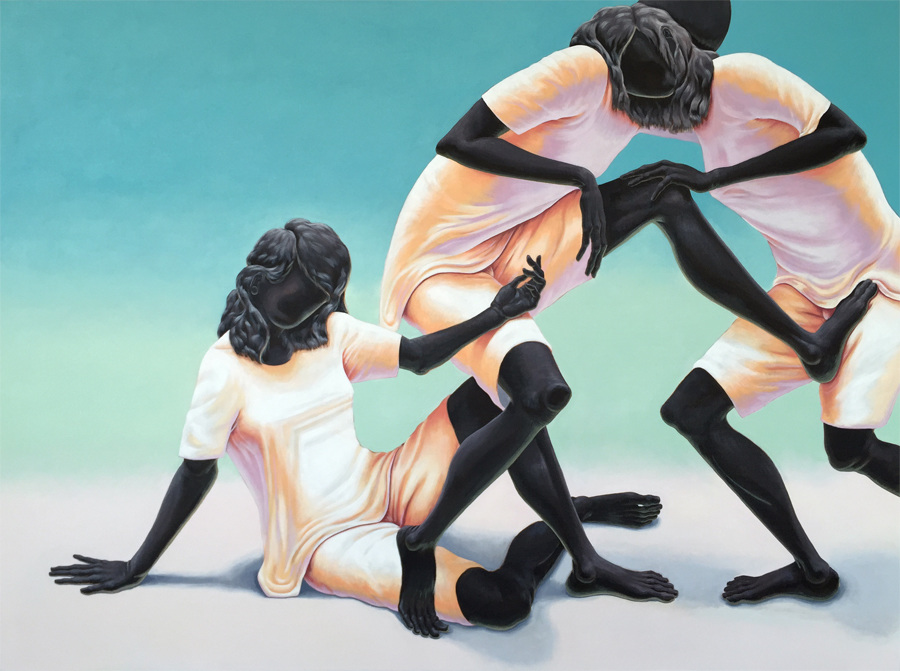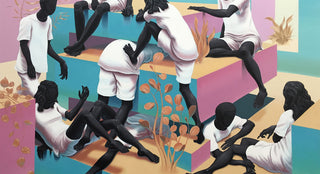In the large-scale acrylic paintings of Los Angeles-based artist Alex Gardner, blank-faced black figures climb on top of geometric shapes and each other. Their intentions are uncertain—in “Can’t See (How Full My Hands Are),” for example, one figure leans on a pastel pink staircase, while another bear hugs an ice-blue potted plant.
But stripping the characters of their identities, and placing them in open-to-interpretation situations, is purposeful: “The viewer can project themselves or whoever they want into the image,” the artist explains. It also allows the artist to explore themes of desire, ethics, and anxiety, and enables the viewer to do so too.
“I just want the viewers to make a connection with the work and have a visceral response—whether it be recalling the past, being reminded of the future, or appreciating the present,” Gardner says in the following interview with The Hundreds. “The goal is to get the person to think at all, to simply be moved.”

ZIO: How did you develop your style?
ALEX GARDNER: Figurative art has been the redheaded stepchild of the art world for some time now, but I think until everyone’s consciousness has been uploaded into servers and we’re all living some incomprehensible digital immortality, figurative art should still be relevant. I’m fighting the good fight.
Why do your characters have blank faces?
There are two main reasons as to why the figures are faceless. One is that I didn’t want them to be obvious portraits of anyone. The figures are not supposed to have any specific identity or outward connections to myself or the people I know. The viewer can project themselves or whoever they want into the image. The other reason is that in depicting a face, I would have to give them a facial expression. Facial expressions would give too much information about the type of emotions the figures are experiencing. This results in a very one-dimensional narrative that is not open to interpretation.

“Facial expressions would give too much information about the type of emotions the figures are experiencing.”
Why are all the characters black? Is this a continuation of the same idea as the facelessness, in so that the characters’ lack of identities makes them open for interpretation? Or is it more cultural or sociopolitical than that?
Originally, yes, the basis was a continuation of the facelessness. I didn’t want to display specific ethnicities in the work. The figures in every aspect have to be completely neutral. It’s interesting, though. I’d say 95% of the people that ask me why the figures are black are white people. I suppose black people just assume the figure’s ethnicity as being black just as nobody questions white people for painting white people.
I find it problematic that people have to assume that there is some kind of sociopolitical statement I am making simply because the figures are black. There is literally no other indication of the art being socio-politically charged. I think it’s shit that we have to constantly answer these types of questions. There has to be a normalization in figurative art where the depiction of a non-white figure can exist without the implication of race being its central theme. So is my work cultural or sociopolitical? In 2016, I suppose it is.
I definitely agree with your response about the normalization of non-white figures in art. But, in your interview with The Fader, you stated that your work was not sociopolitical, but then expanded with this: “That being said, I definitely feel like those things, ideas, and thoughts are inherent in my work. I think I’m unconsciously developing those ideas. Just the fact that I painted black figures in the first place was kind of—it was a conscious decision that I made.” Can you clarify what you meant by that?
What I was getting at is that my ethnic background has an effect on who I am as a person. Just as whether or not my parent’s divorced as a child, whether I grew up on a farm versus a city, or if I grew up with religion or science has an effect. Obviously all of these things, plus many more, are factors in my personality and way of thought. I just don’t like to be defined by my ethnicity.

Do you think stripping down your characters makes it easier to communicate ideas?
I wouldn’t say it’s easier to communicate ideas, but it makes the message more abstract and pure. I’m communicating basic human emotions and their causal relationship to modern existence.
What do you want the viewer to think or understand when looking at your work?
I just want the viewers to make a connection with the work and have a visceral response—whether it be recalling the past, being reminded of the future, or appreciating the present. The goal is to get the person to think at all, to simply be moved. Nothing specific.
What was the last exhibition you went to that moved you?
The Hispanic Society of America in the Upper West Side of Manhattan has a bangin’ collection of massive Joaquín Sorolla paintings.
What is your best piece of advice for aspiring illustrators or artists?
Learn art history, eat less sugar, and be genuinely nice to everyone while simultaneously not giving a fuck about what they think of you.

***
alexgparadise.com. Follow Alex Gardner on Instagram @artposer.

